
|   |

|   |
Anugraham 2025 - A Nrithyodaya Mumbai Festival - Chandra Anand e-mail: chandra6267@yahoo.co.in Photos courtesy: Nrithyodaya Mumbai May 5, 2025 Nrithyodaya - The Academy of Performing Arts, now running in its 50th year, held 'Anugraham' 2025, the 2nd edition of its annual classical music and dance festival this year at Mahakavi Kalidas Natya Mandir, Mumbai, on 15th March. This festival is held to remind us of outstanding persons who have made notable contributions in music and dance traditions of India. It is their "anugraham" and blessings bestowed on us that we are able to continue these cultural traditions forward. This year's event was dedicated to Maharaja Swathi Thirunal. To celebrate this, three performances were lined up. One was Carnatic vocal concert of songs composed by Swathi Thirunal by disciples of Radha Namboodiri. Two, Mohiniattam recital by Gopika Varma who presented "Swathi Bhagawatham," a composition of Swathi Thirunal which brought forth the life story of Lord Krishna in a sequential order, from his birth to death. And a dance drama of Maharaja's biography called "Swacchandah Swathi", a Nrithyodaya Mumbai production in classical dance style of Bharata Nrityam, Mohiniattam and Bharatanatyam. 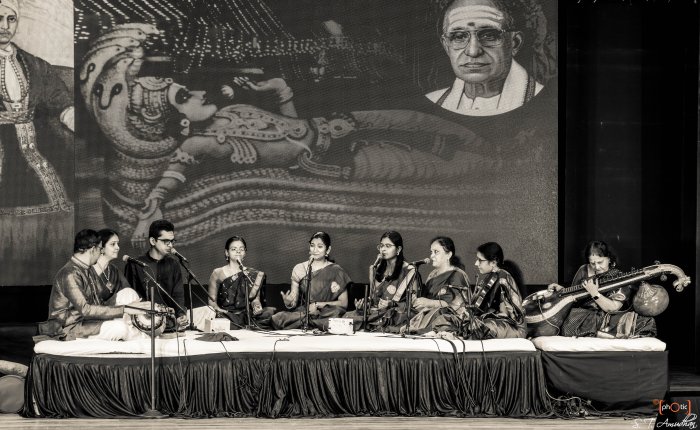 Students of Radha Namboodiri Guru Radha Namboodiri is a student of the legend of Carnatic music, Semmangudi Srinivasa Iyer. It was Semmangudi Mama, as he was popularly known, who brought out several compositions of the Maharaja beyond the borders of Kerala. In fact, it is he who gave a ragamalika format to the famous "Bhavayami Raghuramam" (Ragamalika, roopakam), a composition of Swathi Thirunal which was earlier composed in ragam Saveri only. Four different types of songs composed by Swathi Thirunal were selected from the vast repertoire of 400 songs in different languages including manipravalam. Carnatic vocal concert was sung by Dharini Veeraraghavan, Vimarshini Santosh, Gayathry Krishnachandran, Meera Sridar, Anupama Devarajan and Harikumar, supported on violin by Suja MS, on veena by Praveena Gowthaman and on mridangam by Rohit Prasad. 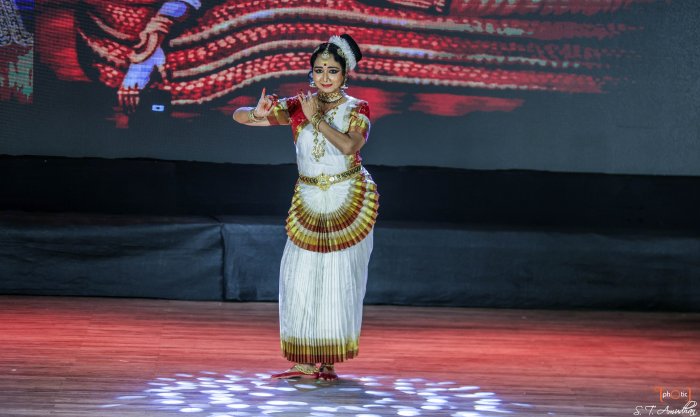 Swathi Bhagavatham by Gopika Varma Gopika Varma, belonging to the Travancore royal family, gave a sincere performance of "Swathi Bhagavatham" (Ragamalika, adi). Like the title suggested, as she regaled us with life story, the experience was like participating in bhakti yoga through shravanam and smaranam of Lord Krishna, through dance and music. 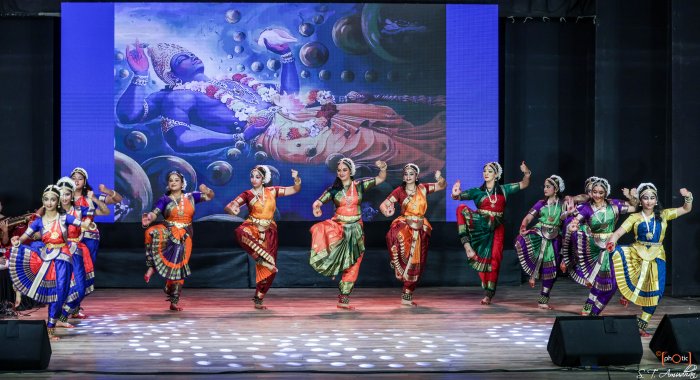 Students of Nrithyodaya 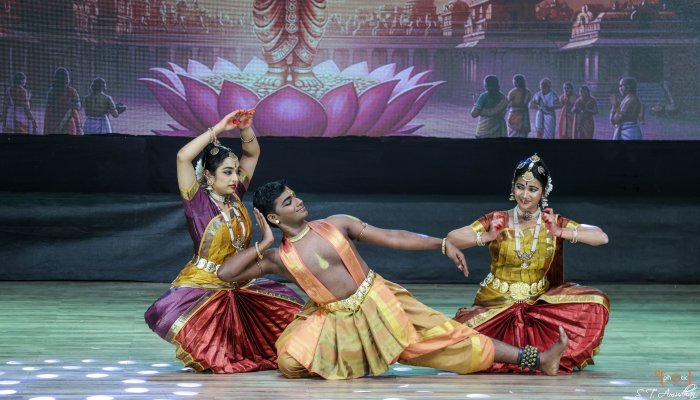 Students of Dr. Sandhya Purechha "Swacchandah Swathi - A Star among Stars" set in presentation format as mentioned in Natyashastra, was conceptualized by Dr. Jayashree Rajagopalan, artistic director of Nrithyodaya, Mumbai, and scripted by Aishwarya Harish (cultural coordinator). This presentation brought out the greatness of Swathi Thirunal as a great man, administrator, his brilliant and exhaustive contributions to music, and, above all as Lord Padmanabha's true devotee, all very much emotionally uplifting. To accentuate the story line, photos through LED images were lit up on the background curtain. Reminiscing the story of the great king through the voice of Lord Padmanabha as sutradhar, as a witness to all that Swathi Thirunal has done, was an apt creative liberty taken as most songs written by him were on Lord Padmanabha proving him to be Swathi Thirunal's ishta devata. The dance drama commenced with a pushpanjali (Bhoopalam, adi) and utsava prabhandam kriti - "Andolika vahana" (Anandabhairavi, misrachapu), a composition of Swathi Thirunal, wherein the utsava murthi alankaram, pooja and pulling of the sacred chariot were shown. The traditional introduction as to why the play was being staged, was done through a conversation between Lord Padmanabha and Sage Narada. Important turning points in Swathi Thirunal's life were focused on by dancing to his compositions on his time line. When he was born, the famous lullaby "Omana thingal" (Kurinji, misrachapu) composed for him by court poet and family friend Irayimman Thampi, was shown in Mohiniattam style by disciples of Guru Jayashree Nair. The song was beautifully portrayed bringing out visually the lyrical beauty of the verses. It was as if the nature brightend up or looked more beautiful with the birth of Swathi Thirunal. The baby was brought up with utmost love and care, and being very intelligent, mastered many subjects. At the age of 16, Swathi Thirunal ascended the throne. "Vande sada Padmanabham" (Navarasa Kanada, adi) in Bharata Nrityam style was performed gracefully as an ode to Lord Padmanabha depicting the temple seva and a few stories of Lord Krishna as a saviour. 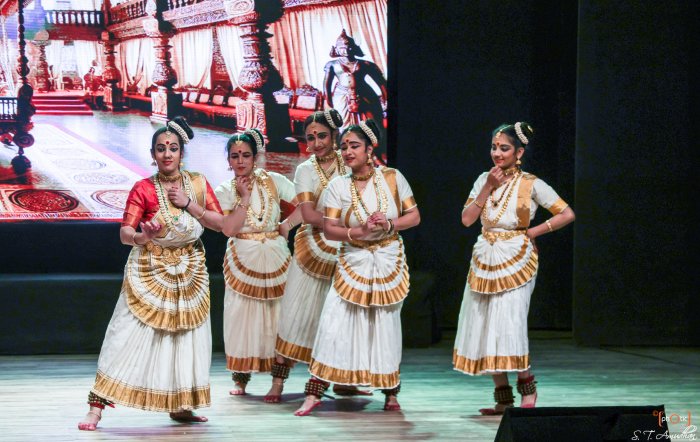 Students of Guru Jayashree Nair 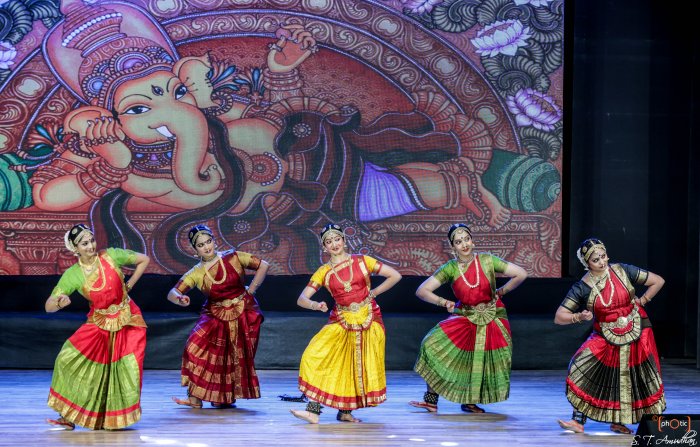 Students of Guru Asha Sunilkumar Swathi Thirunal's aptitude for poetry was depicted with two of his earlier compositions. One, "Paramapurush jagadheesha" (Vasanta, adi) performed by students of Guru Sandhya Purecha. They crisply enacted each of the ten avatars and did padartha bhava for charanam. Two, "Paripahi ganadhita" (Saveri, adi) was performed by students of Asha Sunilkumar. A good mixture of nritta and nritya was used to delineate padartha bhava. The story of birth of Lord Ganesh was enacted and each girl stood in a different pose of Ganesha to end the item showcasing sculpturesque quality of dance. The trinity of music were his contemporaries and seniors to him. Swathi Thirunal's compositions resonated their styles and greatness. His use of chaste Sanskrit language in his sahityam was akin to Muthuswami Dikshitar; the simplicity and bhakti bhavam in his lyrics was akin to Thyagaraja, and the intensity of feelings that all compositions depicted was akin to Shyama Sastri. Like Dikshitar coined raga name into his songs and used ragamudras, songs of Swathi Thirunal too reflected these features. "Anandam Kamalamanohari" (Chatur Ragamalika, adi) was performed to assert or define this point. The nritta choreography for the chitta swaras complimented each other. The Mohini episode of distributing the nectar to Devas and its aftermath was shown with a fighting sequence. Use of swaraksharam was very much a feature in his songs. The real story of Swathi Thirunal being challenged by a musician in court and how he immediately composed a song with swaraksharam at the court itself was related. A beautiful choreography of "Sarasaksha paripalaya mamayi" (Pantuvarali, adi) was performed by artistes of the ABHAI, Mumbai shakha. They aesthetically presented Gajendra moksham and amrut mantan stories and finally stood in Dashavatara poses emphasizing the motifs of Lord Padmanabha in his songs.  Artistes of ABHAI, Mumbai Shakha Swathi Thirunal made his court musicians sing his compositions and that is how his songs survived as he couldn't have students being a king. He was a patron of musicians, thus, the Tanjore Quartet visited him. His closeness to Vadivelu influenced him to create compositions like pada varnams, tillanas, varnams that could be used for performing dance. "Sarasa shara Sundara" (Neelambari, adi) varnam in Bharata Nrityam style was performed to impress on this point. The jathis composed brought out the strong and graceful nritta of Bharata Nrityam style to the fore. For the lyrical expression, the grace of Padmanabha Swami was portrayed through stories of Krishna Leela. Considered as an open-minded king, singers from North of India too went to meet him. Kokilakanta Goswami was patronized by him, Satkaala Govinda Maraar was also in his court showing that he had mastered Hindustani classical style of music too. Hindi Bhajan "Avadha sukhadayi" (Hamirkalyani, adi), describing life of Ram was performed by young students of Nrithyodaya in Bharata Nrityam format and poses of Rama stood out in this item. Swathi Thirunal discovered ragam Mohanakalyani or Bhoopkalyani, where the arohanam was Mohanam and avarohanam was Kalyani. "Seve shrikantam" in adi talam, was presented which was his only composition in that raga. As a young king with an extremely scientific attitude, Swathi Thirunal ensured many progressive reforms in Kerala - like the first astronomical observatory commissioned in the subcontinent, establishment of English schools in all regions of the state, a department for engineering and repair, reforms in traditional laws of justice, starting the Kerala zoo, establishment of printing press and of course ensuring that culture of music and dance became recognized, respectable and aspirational too. Though he was a good administrator, the Britishers interfered in his court affairs. They did not like his fame, or that so much of patronage was done for art, and the expenses done for Lord Padmanabha temple. William Culling, British Resident at his court was not in favor of how the royal house was functioning. Swathi Thirunal was reduced to a figure head only. Troubled by these interferences at the court, Swathi Thirunal gave up his privileges as a ruling king and locked himself in the room. It was shown that Swathi Thirunal then retires to write many songs in service to Lord Padmanabha for the rest of his life. The refrain of "Kripaya palaya shoure" (Charukesi, adi) was sung to accentuate this happening. Lord Padmanabha concluded by saying that Swathi Thirunal was a devotee so pure that he did the Lord's naama smaranam through music. And, of course, ultimately it's because of this nama sankeertanam that his life is still remembered even after 200 years. Thus, it's through nama sankeertanam one receives salvation. The presentation, a drishya kavyam, was ably supported by live music with Harish Venkateswaran on vocals, Sathish Seshadri on violin, Saipriya Vishwanathan on veena, Sriram Subbharaman on mridangam and Shankaranarayanan Ramachandran on moorsing. The Sanmargadarshi Award was given to musician, researcher and teacher in music Guru Radha Namboodiri for her scholarly and prolific guidance in Carnatic music. It was presented to her by the chief guest for the day, Vineet Radhakrishnan, who is the present cultural icon of Kerala and a knowledgeable artiste being a film star and a Bharata Nrityam exponent. The guest of honour who graced the occasion was Mihir Kotecha, MLA of Mulund, Mumbai, who released the souvenir of the year titled "Culture musings" in which a collection of articles on the ongoing cultural happenings and perspectives through eyes of many practitioners and scholars of dance was published. 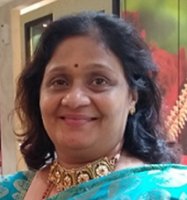 Chandra Anand is a Bharatanatyam artiste and teacher. She has an MA in Bharatanatyam from Tilak Maharashtra Vidyapeeth, and her series on 'Education in spiritual values through Bharatanatyam' is featured in narthaki.com. |